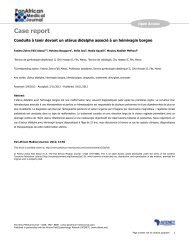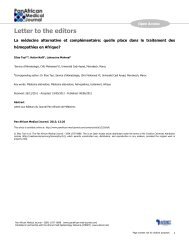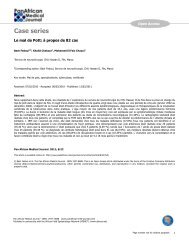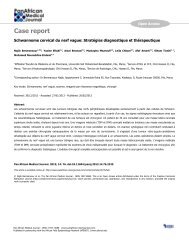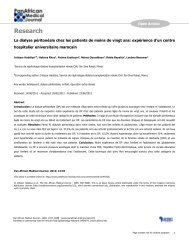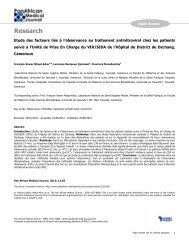Giant gastric lipoma mimicking well-differentiated liposarcoma
Giant gastric lipoma mimicking well-differentiated liposarcoma
Giant gastric lipoma mimicking well-differentiated liposarcoma
You also want an ePaper? Increase the reach of your titles
YUMPU automatically turns print PDFs into web optimized ePapers that Google loves.
Case report<br />
Open Access<br />
<strong>Giant</strong> <strong>gastric</strong> <strong>lipoma</strong> <strong>mimicking</strong> <strong>well</strong>-<strong>differentiated</strong> <strong>liposarcoma</strong><br />
Mohamed Moncef Hamdane 1,& , Ehsen Ben Brahim 1 , Mériam belhaj Salah 1 , Nooman Haouas 2 , Ahmed Bouhafa 2 , Achraf Chedly-<br />
Debbiche 2<br />
1 Department of pathology, Habib Thameur Hospital. 8 rue Aly Ben Ayed. 1008. Montfleury, Tunis, Tunisia, 2 Department of visceral surgery, Habib<br />
Thameur Hospital. 8 rue Aly Ben Ayed. 1008, Montfleury, Tunis, Tunisia<br />
& Corresponding author: Mohamed Moncef Hamdane, 60 Avenue Bahi Ladgham, Ennasr 2, 2037. Ariana, Tunisia<br />
Key words: Stomach, <strong>lipoma</strong>, <strong>liposarcoma</strong>, pathology, cytogenetics<br />
Received: 9/13/2011 - Accepted: 9/2/2012 - Published: 9/23/2012<br />
Abstract<br />
Authors report the case of a 51-year-old man, presenting with epigastralgia of recent onset. Physical exam was unremarkable. Endoscopy revealed<br />
a large, ulcerated, submucosal, antral tumor. CT scan reveals an antral mass with fat attenuation. The patient underwent a total gastrectomy.<br />
Macroscopic examination identified in the antral wall a 9-cm, <strong>well</strong>-circumscribed, nodular lesion, with a yellow, greasy cut surface. On histological<br />
examination, the tumor was composed of a mature adipocytes proliferation, showing significant variation in cell size, associated to some lipoblasts.<br />
Nuclei were sometimes large, slightly irregular, but without hyperchromasia nor mitosis. Diagnosis of a <strong>well</strong>-<strong>differentiated</strong> <strong>liposarcoma</strong> was<br />
suspected and molecular cytogenetic analyses showed no MDM2 nor CDK4 gene amplification on fluorescent in situ hybridization. The diagnosis of<br />
<strong>lipoma</strong> was made. Twelve months following surgery, the patient is doing <strong>well</strong>.<br />
Pan African Medical Journal. 2012; 13:16<br />
This article is available online at: http://www.panafrican-med-journal.com/content/article/13/16/full/<br />
© Mohamed Moncef Hamdane et al. The Pan African Medical Journal - ISSN 1937-8688. This is an Open Access article distributed under the terms of the Creative<br />
Commons Attribution License (http://creativecommons.org/licenses/by/2.0), which permits unrestricted use, distribution, and reproduction in any medium, provided the<br />
original work is properly cited.<br />
Pan Africa Medical Journal – ISSN: 1937- 8688 (www.panafrican-med-journal.com)<br />
Published in partnership with the African Field Epidemiology Network (AFENET). (www.afenet.net)<br />
Page number not for citation purposes 1
Introduction<br />
Lipomas are relatively uncommon tumors in the gastointestinal tract, often located in the right colon [1]. Gastric <strong>lipoma</strong>s are even more unusual<br />
with approximately 220 cases reported in the literature [2]. The diagnosis is strongly suggested by abdominal CT scan findings and is confirmed by<br />
histology. Histopathological diagnosis is usually easy. However, the tumor may sometimes undergo significant inflammatory changes leading to<br />
misdiagnosis of this lesion with a <strong>well</strong>-<strong>differentiated</strong> <strong>liposarcoma</strong> (WDLS).<br />
Patient and observation<br />
A 51-year-old man, in otherwise excellent general health, presented with epigastralgia of recent onset. The patient denied any history of<br />
gastrointestinal hemorrhage, nausea, vomiting, and change in bowel habits, fevers, or melena. Physical examination was unremarkable. Endoscopy<br />
revealed a soft, large, ulcerated, submucosal mass in the <strong>gastric</strong> antrum. Multiple biopsies were obtained but were all superficial, showing<br />
unspecific inflammation of the <strong>gastric</strong> mucosa. The abdominal CT scan revealed a round, <strong>well</strong> circumscribed, low-attenuation, <strong>gastric</strong> antral mass,<br />
measuring approximately 9 cm in diameter (Figure 1). The patient underwent total gastrectomy.<br />
Gross examination of the surgical specimen identified in the antral submucosa, a <strong>well</strong>-circumscribed, smooth, nodular lesion, measuring 9x7.5x5<br />
cm, with a homogeneous, yellow, greasy cut surface. Overlying mucosa was partially ulcerated (Figure 2).<br />
Histological examination revealed a submucosal tumor (Figure 3), composed of a mature adipocytes proliferation, showing significant variation in<br />
cell size (Figure 4), associated to some lipoblasts (Figure 5), in a fibromyxoid background. Nuclei were sometimes large, slightly irregular, but<br />
without hyperchromasia nor mitosis. Many branching capillaries were seen. Areas of lower cellularity, displaying chronic inflammatory changes and<br />
containing bland spindle cells were also noted. The overlying mucosa was ulcerated (Figure 6) and the muscularis propria was focally dissociated<br />
by the tumor. The diagnosis of a WDLS was suspected. An immunohistochemical study was performed. Tumor cells were reactive with anti-HMGA2<br />
and didn’t express S-100 protein, CD34, MDM2 and CDK4. A cytogenetic study was then performed, showing no MDM2 nor CDK4 gene<br />
amplification on fluorescent in situ hybridization (FISH). The diagnosis of a benign <strong>lipoma</strong> was so made. The patient underwent an uneventful<br />
recovery. One year following surgery, he is doing <strong>well</strong>.<br />
Discussion<br />
Gastric <strong>lipoma</strong> is a rare, benign lesion, accounting for only 5% of gastrointestinal tract <strong>lipoma</strong>s and fewer than 1% of all <strong>gastric</strong> tumors [3,4]. They<br />
typically occur in the fifth or sixth decade of life with equal sex incidence [2,4,5]. 75% of <strong>gastric</strong> <strong>lipoma</strong>s are located in the antrum and are usually<br />
submucosal in origin [2].<br />
Page number not for citation purposes 2
Clinical symptoms depend on the size of the lesion. When small (< 2cm), <strong>lipoma</strong>s are usually asymptomatic and they are often discovered<br />
fortuitously [1,3,4]. When the tumors are large (> 3 4cm), patients often present with upper gastrointestinal hemorrhage, either chronic or acute,<br />
caused by ulceration of the neoplasm [1,4]. Abdominal pain and obstructive symptoms are also common, especially if there is endoluminal growth<br />
that could cause intussusception [1,4].<br />
Endoscopically, <strong>gastric</strong> <strong>lipoma</strong>s typically appear as a soft, sharply defined, submucosal mass, often yellow in color as opposed to the surrounding<br />
pink mucosa. Typically, 3 clues help to identify these lesions as <strong>lipoma</strong>s on endoscopic examination: the “tenting sign”, in which the overlying<br />
mucosa is easily retracted with the biopsy forceps; the “cushion sign” which occurs when the forceps produces a soft, cushioning indentation when<br />
applied to the <strong>lipoma</strong>; and the “naked fat” sign, which refers to exposed adipose tissue on the surface of the <strong>lipoma</strong> that pokes through the normal<br />
overlying mucosa after multiple biopsies of the normal mucosa are performed [6]. Occasionally, the he lesion may be associated with a centrally<br />
located, superficial ulceration, caused by pressure necrosis. At times, ulceration can be fairly extensive, leading to the false impression of a more<br />
aggressive lesion [4,6]. Abdominal CT scan is the imaging examination of choice. It strongly suggests the diagnosis by showing a <strong>well</strong>circumscribed<br />
lesion with a uniform, fatty density and an attenuation ranging from 70 to 120 H [4]. Endoscopic ultrasound examinations (EUS) is<br />
also a very good method for the diagnosis of <strong>gastric</strong> <strong>lipoma</strong>s [2]. The typical findings of EUS reveal the tumor as an hyperechoic neoplasm in the<br />
submucosal layer.<br />
Diagnosis is confirmed only after histopathological examination of surgical specimen. Standard biopsies are often inadequate because of the<br />
submucosal location of the tumor. On gross examination, <strong>gastric</strong> <strong>lipoma</strong>s appear as solitary, smooth, soft masses, most often more than 2 cm in<br />
diameter, with an average size of 6.5 cm. On cut surface, they appear bright yellow, round, greasy, and encapsulated unless they have become<br />
infracted. Large lesions may be ulcerated, like in our patient [1,2,4]. Histologically, <strong>gastric</strong> <strong>lipoma</strong>s are sharply circumscribed tumors, usually<br />
surrounded by a thick fibrous capsule. They are composed of mature adipocytes, relatively uniform in size and lacking cytologic atypia. The tumor<br />
is usually centered in the submucosa and often compresses the overlying muscularis mucosae [1,7].<br />
When the tumor is large, there is a progressive tendency for the submucosal mass to extrude into the lumen, leading to traumatic and<br />
inflammatory changes and resulting in necrosis, ulcération, and hemorrhage. Secondary changes including nuclear hypertrophy, hyperchromasia,<br />
fat necrosis, fatty cysts, and foamy macrophages may be observed. Lipoblasts and variation in cells size could, in addition, be present. The tumor<br />
can, in this situation, mimic a WDLS [3,7,8]. In such situation, diagnosis is difficult and morphological features are insufficient to classify the tumor.<br />
Cytogenetics and molecular biology offer new powerful tools for differentiating benign and malignant <strong>lipoma</strong>tous tumors. WDLS are characterized<br />
by giant marker and ring chromosomes, sometimes as a sole finding or occasionally in association with other numerical or structural alterations.<br />
The giant marker and ring chromosomes contain amplified sequences of 12q13-15, the site of several genes (e.g., MDM2, GLI, SAS, CDK4, and<br />
HMGIC). This structural abnormality results in the consistent amplification of MDM2 and the frequent amplification of the adjacent genes, SAS,<br />
CDK4, and HMG1C [8]. The high specificity and sensitivity of detection of MDM2 and CDK4 amplification in WDLS and de<strong>differentiated</strong><br />
<strong>liposarcoma</strong>s have been demonstrated and analysis of these abnormalities using FISH or polymerase chain reaction has recently been shown to be<br />
an interesting means of identifying and separating WDSL from various benign <strong>lipoma</strong>tous lesions [8-10].<br />
The treatment of choice for a symptomatic <strong>gastric</strong> <strong>lipoma</strong> is circumferential excision with a clear margin of normal tissue. Due to the benign nature<br />
of this lesion an extensive surgical procedure such as an extended gastrectomy is not necessary. Simple local enucleation or partial <strong>gastric</strong><br />
Page number not for citation purposes 3
esection is sufficient to remove the <strong>lipoma</strong> without fear of relapses or malignant degeneration [2]. The prognosis of patients with <strong>gastric</strong> <strong>lipoma</strong>s<br />
is good. Malignant degeneration has not been reported [2].<br />
Conclusion<br />
Fatty tumors are rare in the gastrointestinal tract. Differentiating benign from malignant neoplasms is sometimes difficult in morphologic features.<br />
Cytogenetic procedures are, in these cases, the only means for an accurate diagnosis.<br />
Competing interests<br />
The authors declare no competing interests.<br />
Authors’ contributions<br />
All the authors have contributed to this manuscript is ways that are compliant with the ICMJE authorship criteria. All the authors have read and<br />
approved the final version of this manuscript.<br />
Figures<br />
Figure 1: Abdominal CT scan: A large, low-attenuation, <strong>gastric</strong> mass<br />
Figure 2: Macroscopic features: A <strong>well</strong>-circumscribed nodular lesion with a yellow, greasy, cut-surface<br />
Figure 3: An adipocytic proliferation located in the submucosa (HEx40)<br />
Figure 4: The tumor is made of an adipocytic proliferation showing a significant variation in cells size, with many branched capillaries, in a<br />
fibromyxoid background (HEx100)<br />
Figure 5: Lipoblasts are present within the adipocytic proliferation (HEx400)<br />
Figure 6: The overlying mucosa is focally ulcerated (HEx40)<br />
Page number not for citation purposes 4
References<br />
1. Odze RD, Goldblum JR. Surgical Pathology of the GI Tract, Liver, Biliary Tract and Pancreas. 2nd ed. Saunders Elsevier: Philadelphia,<br />
2009<br />
2. Saltzman JR, Carr-Locke DL, Fink SA. Lipoma Case Report. MedGenMed. 2005 Jan 18;7(1):16. This article on PubMed<br />
3. Fernandez MJ, Davis RP, Nora PF. Gastrointestinal <strong>lipoma</strong>s. Arch Surg. 1983 Sep;118(9):1081-3. This article on PubMed<br />
4. Thompson WM, Kende AI, Levy AD. Imaging characteristics of <strong>gastric</strong> <strong>lipoma</strong>s in 16 adult and pediatric patients. AJR Am J Roentgenol.<br />
2003; 181(4):981-985. This article on PubMed<br />
5. Chu AG, Clifton JA. Gastric <strong>lipoma</strong> presenting as peptic ulcer: case report and review of the literature. Am J Gastroenterol. 1983;<br />
78(10):615-618. This article on PubMed<br />
6. Taylor AJ, Stewart ET, Dodds WJ. Gastrointestinal <strong>lipoma</strong>s: a radiologic and pathologic review. AJR Am J Roentgenol. 1990;<br />
155(6):1205-1210. This article on PubMed<br />
7. Fenoglio-Preiser CM, Noffsinger AE, Stemmermann GN, Lantz PE, Isaacson PG. Gastrointestinal Pathology: An Atlas and Text, 3rd<br />
Edition. Lippincott Williams & Wilkins: Philadelphia, 2008<br />
8. Weiss SW, Goldblum JR. Enzinger and Weiss's Soft Tissue Tumors, 5th ed. Mosby Elsevier: Philadelphia, 2008<br />
9. Boltze C, Schneider-Stock R, Jäger V, Roessner A. Distinction between <strong>lipoma</strong> and <strong>liposarcoma</strong> by MDM2 alterations: a case report of<br />
simultaneously occurring tumors and review of the literature. Pathol Res Pract. 2001; 197(8):563-568. This article on PubMed<br />
10. Shimada S, Ishizawa T, Ishizawa K, Matsumura T, Hasegawa T, Hirose T. The value of MDM2 and CDK4 amplification levels using realtime<br />
polymerase chain reaction for the differential diagnosis of <strong>liposarcoma</strong>s and their histologic mimickers. Hum Pathol. 2006;<br />
37(9):1123-1129. This article on PubMed<br />
Page number not for citation purposes 5
Page number not for citation purposes 6
Page number not for citation purposes 7
Page number not for citation purposes 8
Page number not for citation purposes 9
Page number not for citation purposes 10
Page number not for citation purposes 11



